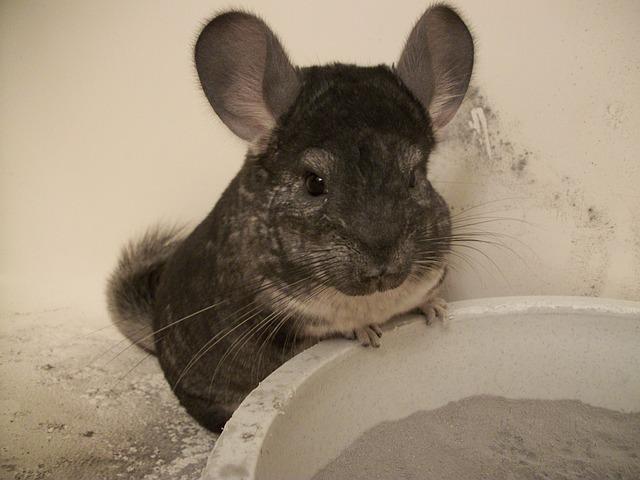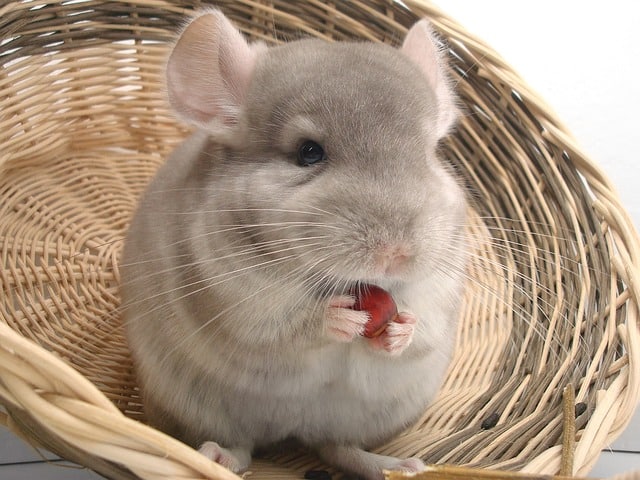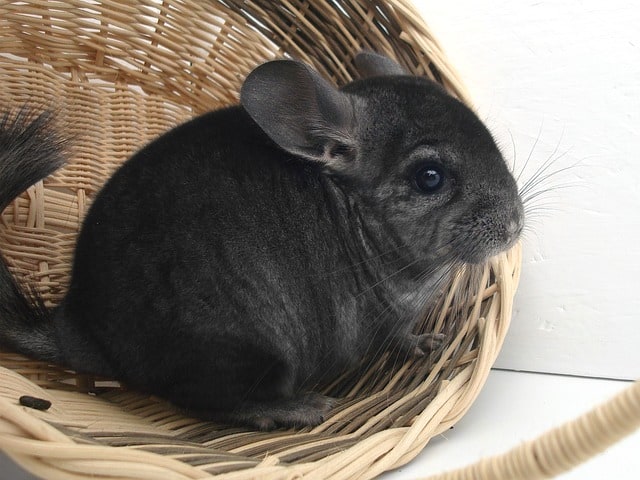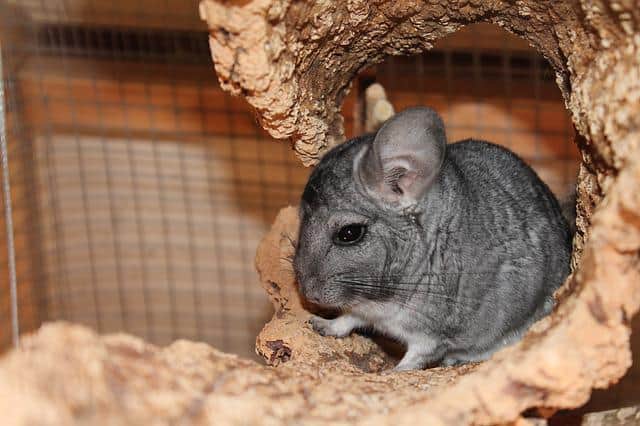
Owning a chinchilla is not only one of the most exotic pets, but it is also very rewarding. These pets make wonderful companions. They are not extremely large mammals, but not as small as a guinea pig or hamster.
Table of Contents
The chinchilla has thick, plush fur that is super soft, and yes, this is why Chinchilla fur has been used to make fur coats. With their large beautiful eyes, it is hard to not find yourself in love with one of these companions.
The reason their fur is so soft and dense is that they have between 60 and 70 hairs that sprout from each hair follicle. No other animal, mammal or human included can boast the same achievement.
Fur this thick and dense serves multiple functions for the little chinchilla, however, this fur is also extremely difficult to dry. Needless to say, you will not give a chinchilla a bath the way you do many other pets.
The Chinchilla does need to avoid getting wet at all costs. The water would get trapped between the dense fur and the skin. This can obviously lead to different skin diseases for the chinchilla.
What does a Chinchilla use to bathe?

A chinchilla obviously is not going to take a bath as you would, or as you would give a dog or cat. The Chinchilla will actually sit inside a box type of dish and roll around or fluff this Chinchilla dust all over himself.
A chinchilla will perform three separate steps when it comes to taking a bath. The first step involves getting into the dust container, whether that is a box or a bowl that is large enough to fit the Chinchilla. The second step that the Chinchilla takes is to dig in the sand or dust and pull it towards its body. They will then rub their cheeks into the dust and finally as they lay on their backs, they will spin.
This may appear to look like the Chinchilla is playing in a sandbox, but this is not a sandbox to play in. It does appear to be a fun routine if you ever watch the Chinchilla do its bathing. The best part about the Chinchilla having a dust bath is that it is really an uplift to their mental health as well. As stated, it appears as though they are playing, when they spin around and around.
Why do they use dust?

A chinchilla does not use just any dust to clean itself. Where the Chinchilla comes from, which is high up in the Mountains, in South America, they use volcanic ash as the dust for bathing.
The Chinchilla will use the dust as a way in which to spread the natural oils around, the dust also helps to remove and clear away the dirt and debris and it actually keeps their fur super soft.
How often should a Chinchilla use a dust bath?

The Chinchilla does not need to have access to Chinchilla dust on a daily basis. The Chinchilla dust should also not be left in the cage with your Chinchilla. The sweet little guy may decide to use the bath with the Volcanic ash as a litter box. This would truly defeat the purpose of a bath then.
The Chinchilla is a nocturnal animal, so when offering the dust bath, it should be given a couple of times a week and in the evening. The Chinchilla should not need a bath more often than that.
For those areas that are higher in humidity, the Chinchilla may need to bathe up to 4 times a week. To reiterate, if the Chinchilla takes a bath too often, the skin, ears and feet could begin to dry out.
How long should It be left?

You do not want to leave the bathing box available for any longer than 10 to 15 minutes, a couple of evenings per week. And the box should never be left in the cage permanently. The Chinchilla may use it as a litter box or begin to bathe too often.
However, how often per week, depends on the Chinchilla himself. If the little guy’s fur begins to look rough and dirty, you may choose to allow your Chinchilla an extra bath.
What is chinchilla dust?

What the Chinchilla uses as dust is not something you would expect. Where they come from, so high up in the mountains of South America, they use the ash from the Volcanos.
However, since it is not as easy as we would like to obtain this Volcanic ash for our Chinchilla, there are ways to purchase it online.
As the owner, you need to be sure it is high quality, preferably volcanic ash itself. You need to find one that has been naturally sourced, one without the use of chemicals to produce it.
There are multiple products on the market that are sold as Chinchilla dust. However, if it looks like grains of sand, it is most definitely not dust. This would be more of an abrasive sand product and chinchillas will not use it.
This is the same as the companies that attempt to sell baby powder or similar products and claim it is Chinchilla dust. To each his own, however, my Chinchilla is going to use the recommended Volcano ash so that he is comfortable and clean.
Dust that is too thin could be just as bad for a chinchilla. The powder would likely stay in the hair, next to the skin and that could cause dry skin and other issues that the Chinchilla does not need.
This would also mean that you should not use any other product that is designed for an animal other than a Chinchilla. The formulation of some products can be harmful to animals that it is not meant for.
Active and agile

As you know, the Chinchilla is active and quite agile. So once he gets in bath mode, watch the little guy go nuts. All these movements that they make: the shimmy, spin, flipping and kicking dust-up, are actually done for a purpose.
It is with all these athletic moves that the Chinchilla is able to get the dust where it needs to be in order to clean the dirt and debris from his fur. This makes it clean and not smell.
The Chinchilla is so agile at this bathing ritual that you only need to have roughly an inch of Chinchilla dust at the bottom of the bathing box. The chinchilla is able to spin around and kick enough of the Volcanic ash to the parts of his body, it does not take a large amount of the dust.
Bathing box

I am not even sure if there are actually items called Bathing Boxes. However, for a chinchilla to bathe comfortably, you need to have a box or dish of sorts that is slightly larger than the Chinchilla himself. This is so your Chinchilla is able to move around and roll around to get the dust where it needs to be.
Bath dust
The Volcanic ash bath dust is perfectly safe to use more than once or twice. However, if the dust begins to look clumpy or dirty, or begins to collect debris, it should be thrown out and fresh bath dust used for the next bathing time.
The bath dust that a Chinchilla needs must be Volcanic ash or as close as one can find. There is no logical reason to substitute with sand which is too gritty and will hurt, or with talcum powder which can also do harm to the eyes, ears, and the Chinchillas’ breathing system.
Stick with the tried and true and get your Chinchilla the products they need to stay clean and healthy.
Privacy

It would only be proper to allow the bather to have some privacy. However, luckily, the Chinchilla does not seem to be bothered by onlookers. Especially if the onlooker is the Chinchilla owner and friend.
Sitting there with your little Chinchilla while he bathes may also build the all-important bond of human to animal.
Sometimes it is difficult to say no to the little fur ball when he gives you the eyes begging for a bath. Too much of a good thing is not going to be a good thing if it begins to be harmful. Yes, it could become harmful if the skin becomes too dry. Dry skin on a chinchilla is not something that is remedied by allowing them to have a long soak in warm water. Chinchillas should not be placed into the water for the exact opposite reason. The skin would become too moist and unable to dry due to the dense fur. The fur also would not be able to be dried easily.
If you do notice that your Chinchilla seems to be itching, or if there seems to be an issue with a damp coat of fur, the Chinchilla should be taken to the Veterinarian that is trained in regard to Chinchillas and has experience treating them.
